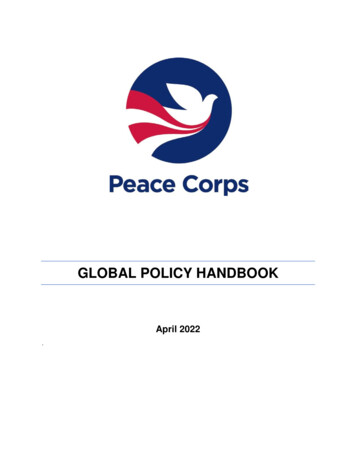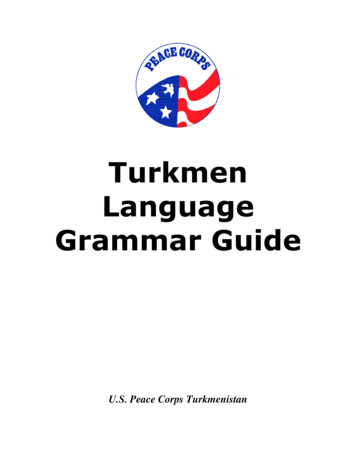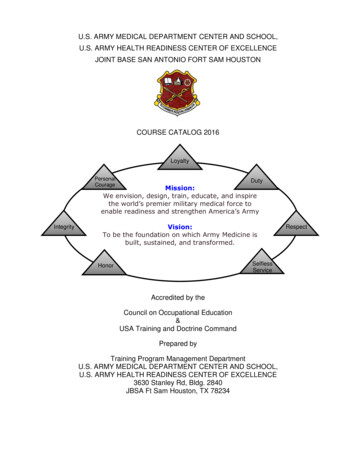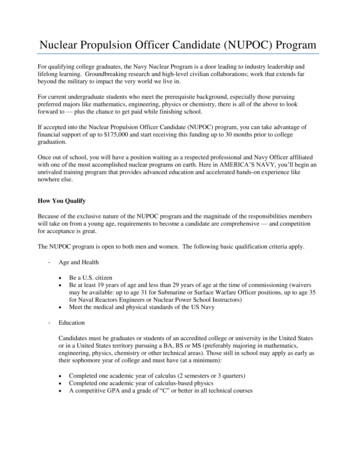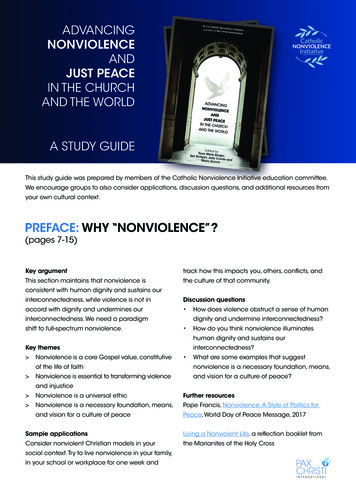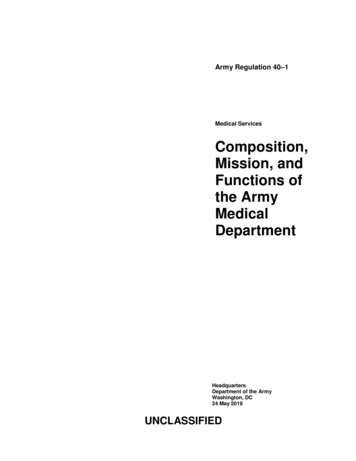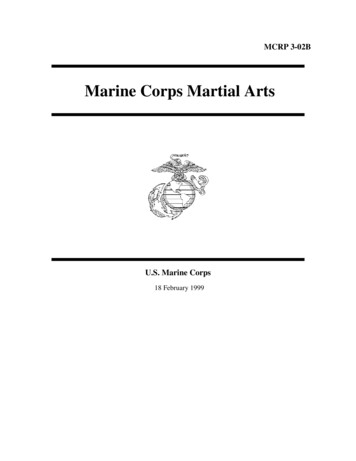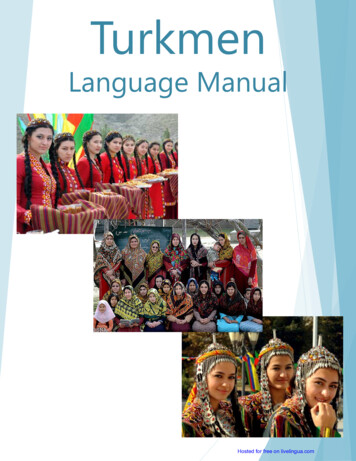
Transcription
TurkmenLanguage ManualHosted for free on livelingua.com
TABLE OF CONTENTSAuthor's PrefaceTable of ContentsA Brief Introduction to the Turkmen LanguageTopic1.2.3.4.1:PersonalIdentificationTo express initial greetingsTo identify and introduce oneselfTo ask and respond about well-beingTo say goodbyeTopic 2: Conversations with1.2.3.4.HostsTo ask and answer personal information questionsTo exchange information about familiesTo make a polite request for privacyTo express gratitudeTopic 3: Food1.2.3.To identify types of foodTo order food at a restaurantTo refuse food or drink politelyTopic 4:1.2.To find means of transportation and destinationTo purchase a train ticket with local currencyTopic 5:1.2.TransportationDirectionsTo ask for and give locations of buildingsTo express lack of understanding of directionsHosted for free on livelingua.com
Topic 6: Shopping1.2.3.To ask for items, prices and quantitiesTo bargain for itemsTo shop at a state storeTopic1.2.3.4.7:CommunicationsTo mail a letter or parcelTo get one's party on the lineTo leave a phone messageTo order and make an international phone calfTopic 8: Medical1.2.To ask and respond to questions about illnessTo report an emergencyTopic 9:1.2.3.4.SocialSituationsTo converse about the weatherTo 'invite and respond to invitationsTo give and respond to complimentsTo describe one's emotional stateTopic 10: At the Workplace1.2.3.4.To identify self and describe Peace Corps assignmentTo apologize for coming lateTo ask about job-related functionsTo decline a request to loan books or materialsHosted for free on livelingua.com
Appendix 1:The Competencies in EnglishAppendix 2:CalendarAppendix 3:NumbersAppendix 4:TermsAppendix 5:Forms of AddressAppendix 6:Anatomy and HealthAppendix 7:SchoolAppendix 8:VerbAppendix 9:Glossary of Words in Dialogsof RelationshipTerminologyConjugationHosted for free on livelingua.com
Authors'PrefaceThis manual of the standard Turkmen language is intended to facilitatethe acquisition of basic language skills that Peace Corps volunteers will needto enrich their tour in Turkmenistan.Conceivably, its materials may b ; usedin conjunction with a textbook for teaching Turkmen at the university level.Mr. Tyson and Professor Clark of the Department Central EurasianStudies at Indiana University collaborated on and share responsibility for boththe Turkmen and the English portions of the text.At the same time, theauthors wish to acknowledge their gratitude for the assistance of the followingindividuals.This project benefitted greatly from the assistance of a number ofindividuals at Magtymguly Turkmen State University in Ashgabat, namelyProfessors Rejepali Nazarov and Guichmyrat Durdymyradov, who helped Mr.Tyson tremendously during his fieldwork in Turkmenistan. The Peace Corpsstaff in Ashgabat, especially Mr. Mark Holt and Ms. Brenda Oldfield, alsoassisted Mr. Tyson in many ways during his stay.Project conrsultant Ms. Nancy Clair made numerous suggestions thathelped to improve the text. All shortcomings, however, remain with theauthors.Hosted for free on livelingua.com
IntroductionA Brief Introduction to the Turkmen LanguageTurkmen is a member of the widespread TurkicAanguagefamily. These languages, whose speakers number around 150 millionpeople, are spoken in Siberia (Yakut), China (Uygur), Central Asia(Turkmen, Uzbek, Kirgiz, Kazak), Russia (Tatar), and the Near East(Turkish). Turkic languages share a common grammar andvocabulary, but only a few of them are close enough today to easemutual understanding. Turkmen speech is so distinctive that itconstitutes an independent Turkic language, spoken by more than2,700,000 people (1989).Standard Turkmen was formed in the Soviet period primarilyon the basis of the dialects spoken by Teke and Yomut groups of theTurkmen people, but it is not identical with any single dialect. Ingrammar and vocabulary, Turkmen has many features in commonwith Azeri and Turkish and with some dialects of Turkic speakers inparts of Afghanistan, Iran, and Uzbekistan. Russian constructionsand words in the standard literary language are a visible reminder ofthe Soviet period. Uzbek has exerted an influence on the speech andvocabulary of Turkmen spoken in the eastern part of the republic.Arabic and Persian words and constructions form a classicalheritage of the centuries of use of the Central Asian Turki literarylanguage in Arabic script.Standard literary Turkmen has been written in a modifiedCyrillic script since 1940. From 1928 to 1940, Turkmen waswritten in a Latin alphabet.The current Turkmen alphabet does not represent accuratelyall the sounds of the speech of educated Turkmen. This is especiallytrue of the vowel sounds. The alphabet consists of 36 letters andtwo signs in the following alphabetic order: A a, B 6, B B, f r, g, E 11n,Pp,Cc,TT,In,s, bI bl, b, 3 3, 0, /0 10, 51 51.Y y, Y y, (1) cp, X x, u,1-1Hosted for free on livelingua.com
IntroductionA Brief Introduction to the Turkmen LanguageTurkmen is a member of the widespread Turkic languageThese languages, whose speakers number around 150 millionpeople, are spoken in Siberia (Yakut), China (Uygur), Central Asia(Turkrnen, Uzbek, Kirgiz, Kazak), Russia (Tatar), and the Near East(Turkish). Turkic languages share a common grammar andvocabulary, but only a few of them are close enough today to easemutual understanding. Turkmen speech is so distinctive that itconstitutes an independent Turkic language, spoken by more than2,700,000 people (1989).family.Standard Turkmen was formed in the Soviet period primarilyon the basis of the dialects spoken by Teke and Yomut groups of theTurkrnen people, but it is not identical with any single dialect. Ingrammar and vocabulary, Turkmen has many features in commonwith Azeri and Turkish and with some dialects of Turkic speakers inparts of Afghanistan, Iran, and Uzbekistan. Russian constructionsand words in the standard literary language are a visible reminder ofthe Soviet period. Uzbek has exerted an influence on the speech andvocabulary of Turkmen spoken in the eastern part of the republic.Arabic and Persian words and constructions form a classicalheritage of the centuries of use of the Central Asian Turki literarylanguage in Arabic script.Standard literary Turkmen has been written in a modifiedCyrillic script since 1940. From 1928 to 1940, Turkmen waswritten in a Latin alphabet.The current Turkmen alphabet does not represent accuratelyall the sounds of the speech of educated Turkmen. This is especiallytrue of the vowel sounds. The aIphabet consists of 36 letters andtwo signs in the following alphabetic order: A a, B 6, B B, F r, A TA, E e,Ee,Xx, TT,Y y, Y y, 41) ch, X x, LJu, Ill ut, TIIiu,i, bI bi,3 3, 3 a, 10 io,51i.Hosted for free on livelingua.com
IntroductionVowelsBeginners should take care to learn the difference between"short" and "long" vowels, because each vowel letter or letter-groupin Turkmen can be pronounced with "short" or "long" duration. Thisdifference often is all that distinguishes the meanings of twowords."Short" vowels are approximately like simple vowels instandard American English; for example a in 'call'. Pronouncing a"long" vowel requires keeping the mouth in the same position for alonger time, for the space of two vowels. English has no trueequivalents of long vowels, because it has "diphthongs" or doublevowels that are different from each other; for example, inpronouncing the word 'wrote' the English speaker actually makes ointo two different vowels (oh--ooh).The 17 vowels of Turkmen are represented by the followingletters or letter-group:aPronounced "short" as English a in the word 'call.' In wordswith a long a, it is pronounced as a drawn out English aa in'bah (humbug').aPronounced only short as English a in 'ant'. In words with along a, it is pronounced as a drawn out a as in 'ant'.3, ePronounced short as English a in 'say', but without the glideinto a diphthong (say-ee). There are only two Turkmen wordswith a long e: 6ep 's/he will give' and rep 's/he will come'. Theletter 3 is used at the beginning of a word, and e elsewhere in aword.131Pronounced short as English u in 'radium'. In words with a longIA, it is pronounced approximately as a drawn out u in 'radium'.Pronounced short as English e in 'end'. In words with a longit is prounounced approximately as English e ea in 'be easy'.oPronounced short as English o in 'stone' but without the glideinto a dipthong (sto-oon). In words with a long 0, it isprounounced approximately as a drawn out English o in 'oh'.,1Hosted for free on livelingua.com
IntroductionPronounced short as English u in 'truth'. In words with a longy, this sound is pronounced approximately as a drawn-outEnglish oo in 'ooh'.oPronounced short as German ö in 'Körper' [body], which may bepronounced by pronouncing e and rounding the lips. In wordswith a long e, it is prounounced with a longer duration thanshort e.Pronounced short as German ü in 'Brücke' [bridge], which maybe pronounced by forming i and rounding the lips.YfiThis is the only long vowel represented distinctly in theTurkmen alphabet. In words with a long y, this sound ispronounced with a longer duration than y.The following doublets (two words spelled the same butpronounced differently) will illustrate the distinction between shortand long vowels in Turkmen (with the exception of 3, e and a)SHORTLONGaT'horse'aTrbI3'get excited!' (imperative)rbI36Hrt'know!' sh!' (imperative)eq'revenge'rypT'dry cheese, curd'rypT'wolf; worm'gym'come down!' (imperative)Aythil'dream''name'3i()Hosted for free on livelingua.com
IntroductionBeginners should keep in mind that the Turkmen alphabetdistinguishes only between short y and long pl. Although similar inappearance, short y is not distinguished from long y by the letters yit-- in a word like gyfirm 'sense, feeling' the letters yit are pronouncedas English ewey in 'Dewey'.ConsonantsTurkmen consonants are represented by the following letters:Pronounced as English p in 'pen'.Pronounced as English t in 'stop'.Pronounced as English k in 'keep' when in words with thevowels a, e, H, o, y but as English c in 'call' when in words withthe vowels a, ht, 0, y.6Pronounced as English b in 'boy' at the beginning of a word andsimilar to v in some other positions.Pronounced as English d in 'deep'.Pronounced as English g in 'geese' when in words with thevowels a, e, n, 0, y but as a sound like English gh in 'yoghurt' inwords with a, bl, o, y.Pronounced as English m in 'meat'.Pronounced as English n in the word 'snow'.Pronounced as English ng in 'sing'.Pronounced as English I in 'look'.Pronounced the same way as English r in 'drill', but with a flapof the tounge.Pronounced as English th in 'thin' in Turkmen (including Arabicand Persian) words, but as English s in 'sun' in words comingfrom Russian.4Hosted for free on livelingua.com
Introduction3Pronounced as English th in 'then' in Turkmen (ncluding Arabicand Persian) words, but as English z in 'zoo' in words comingfrom Russian.mPronounced as English sh in 'share'.Pronounced as English ch in 'check'.A(Pronounced as English s in 'treasure' in words from Russian.Pronounced as English j in 'juice'.xPronounced as English h in 'hall' in some Turkmen words, but asch in English-German 'Bach' in other Turkmen words.coPronounced as English f in 'four'.BPronounced as English w in 'wagon' in Turkmen (includingArabic and Persian) words, but as English v in 'very' in wordsfrom Russian .'Pronounced as English y in 'yes'.Pronounced as English ya in 'yawn'.Pronounced as English ye in 'yea verily', but only when thisletter appears at the beginning of a word or after a vowel.When it appears after a consonant, it is pronounced as Englisha in 'say'.Pronounced as English yo in 'yoke'.ioU, itPronounced as English you in 'youth'.LI 13These letters and signs are used in words from Russian.Turkmen often pronounce u as English s and in as Englishsh, and many times disregard the signs b and 7.altogether.5Hosted for free on livelingua.com
introductionSeveral Turkmen letters have unexpected pronunciations:Pronounced as English th in 'theory' or 'math', instead of S.(except in Russian words).3Pronounced as English th in 'their' or 'mother', instead of z(except in Russian words).Several Turkmen letters may have two very distinctpronunciations:Pronounced as English h in 'hill' and 'aha' in some Turkmenwords, but as a harsh sound without English equivalent in otherTurkmen words. The latter is similar to the soft g sound, butwithout a voiced quality. In Russian words, this letter isalways pronounced as a harsh sound.Pronounced as English g in 'gill' and 'organ' when the Turkmenword has any of the vowels a, e, 11, a, y but as a soft soundwithout an English equivalent when the Turkmen word has anyof the vowels a, hi, 0, y. It is similar to the x sound, but with avoiced quality. In words from Russian, r is always pronouncedas inOne set of letters and their corresponding sounds may presentdifficulties for the beginner. These represent the sound y plus anyof the vowel sounds:(English ya in 'yawn'; long: no English equivalent)(English ye in 'foyer': long: no equivalent)ibi(English yea in 'yeast'; long: no equivalent)(English yo in 'yoke'; long: no equivalent)(English you in 'youth': long: no equivalent)iim(roughly English yu in 'yuk'; long: no 'quivalent)io(y plus vowel like German oe in 'Goethe'; long: no equivalent)Iy(y plus vowel like German ü in Itliss'; long: no equivalent)6Hosted for free on livelingua.com
IntroductionVowel HarmonyStudents of Turkmen should be prepared to learn a number ofrules of pronunciation of vowels, as well as of consonants that arenot reflected in the script. One of the most distinctive features ofTurkmen is vowel harmony.The vowels of Turkmen words share similarities that producea kind of "harmony" in speech. Turkmen words may contain onlyvowels pronounced in the front of the mouth:aaaem 'world', ['pia 'fault, sin'3, e3pKeK 'male, man', re3ea 'beautiful'unepvi 'forward', ryqau 'powerful, strong'elm 'pasture', ceramic. 'to love'y3ewin 'stirrup', ivipixtm 'possible, permissible'Or, Turkmen words may contain only vowels pronounced in theback of the mouth:aaqui( 'open', 6aTup 'hero'161bnicaH 'human', iimaaH 'snake'OIOH 'game', copar 'question'yam 'big', rymaK 'belt, sash'All Turkmen words observe this kind of "front-back" harmony.Many also obsarve a second kind of harmony that affects the vowelsof endings. Turkmen vowels may be pronounced with or without arounding of the mouth. Those pronounced with rounding are thefollowing: o y eyThose vowels pronounced without rounding are:a a e hiIf7Hosted for free on livelingua.com
IntroductionWhen a Turkmen word contains a rounded vowel, then theending also is pronounced with a rounded vowel. However, Turkmenspelling does not reflect this:6y3 'ice'6y3nb1x 'glacier' 6y3 SIbIK (pronounced 6y3nyx)6y3SIbI 'icy'6y3 .rm (pronounced 6y3ny) NOMINAL AND VERBAL WORDSTurkmen has two basic types of words: nominals and verbals.Nominals are 'noun-like' words and verbals are 'verb-like' words.Endings (suffixes) of various kinds are added to both.Nominals include classes of words that in English are callednouns, pronouns, adjectives, some adverbs, and verbal nouns; forexample, Turkmen gerwep 'notebook', rim 'big'. As in English, aTurkmen adjective may stand before a noun or serve as a verbal noun:T(engepum ynbr.'My notebook is big.'Yam Aerweprirm.'My big notebook is.'Verbals include those kinds of words that are equivalent toEnglish verbs and gerunds; for example, rxT 'go!' (imperative from theverb rwrmex) andBITI411 'going'.Beside nominals and verbals, Turkmen has a small number ofparticles, conjunctions, and similar words which do not takeendings; for example, xem 'also, too' and Be 'and.'As a. rule, the last syllable of a Turkmen word is stressed.However, particles and certain suffixes added to the ends of wordsare not stressed.8Hosted for free on livelingua.com
IntroductionSUFFIXATIONThe meanings of Turkmen words, as well as their grammaticalfunctions within sentences, are indicated by adding elements calledsuffixes to the ends of the words. These suffixes or endings areclearly distinguishable as such, especially in writing; for example:.1-bi3napbtr.4rm3 nap bm'my daughters''daughter smy'WORD FORMATION SUFFiXESTurkmen forms new words, both nominals and verbals, bymeans of suffixation, or the addition of endings to existing roots andwords. The addition of a suffix to a nominal word creates a newnominal or verbal word:TOW'new, fresh'TO3e.3111( TO3e JIIIK'innovation, reform, news'Townemex Tan ae mex'to reform, renew'Adding a suffix to a verbal word results in the formation of anominal or verbal word with a new lexical meaning:Ta3e.aemeic'to reform, renew'Towne }mei( Ta3e-i-ne H Meic'to be reformed, renewed'Ta3eneme Ta3e ste me'reform, renewal'9Hosted for free on livelingua.com
IntroductionGRAMMATICAL SUFFIXESThe grammatical functions of Turkmen words within sentencesare expressed by adding suffixes to them. Such suffixes indicatenumber, case, mood or tense. The addition of a grammatical suffixto a word changes its relationship to other words in the sentence;however, it does not change its lexical meaning.Lexical MeaningGrammatical Melningre3 'eye'ro3 ii 'the eye' (object)r 03013 'without an eye're3yrvni Km8.4Aym 'I shut my eye're3nemeic 'look for, search're3neptim 'I searched'PLURAL SUFFIXThe Turkmen plural suffix nap may be added to a nominal toindicate that there is more than one subject or object of a sentence.When the subject of a verb is plural, this ending may or may not bradded:rbI3 'girl, daughter'rbi3nap 'girls, daughters'Tbi3nap rwram(nep)'The girls left.'FbIanapm repgy(nep)They saw the girls.'-After a numeral, the plural suffix is not added:g141.11 'tooth'At4m.riep 'teeth'14KI4 'two'IIKI4 AIM IWO teeth'10Hosted for free on livelingua.com
IntroductionCASE SUFFIXESCase suffixes express relationships between nominals towhich they are added and other nominals or verbais. Their Englishequivalents include 'in', 'at', 'on', 'from', 'of', 'the', and other ideas:tvtelmen 'school'metc,rterme 'in the school'ell 'house'ee 'to the house'Auira6aT 'Ashgabat'Amra6arraaFt 'from Ashgabat'POSSESSIONThere are several ways to express possession in Turkmen.A common way is the addition of possessive suffixes to a nominal.KaKa 'father'Kaicam 'my father'oil 'house'eRyit 'your house' (singu'ar)gOCT 'friend'AocTIA 'his/her friend'A second way to express possession is to form the possessiverelationship construction. In Turkmen, the possessor is placedbefore the possessed. An example of this type of construction inEnglish is 'my father's house' or 'the house of my father', where'father' is the possessor and 'house' is the possessed. The suffix 11 Ft'of' often is added to the possessor, while the possessive suffix (c)u always is added to the possessed:Kaicambut ermKaKa m uni'father my of house his' 'my father's house'11Hosted for free on livelingua.com
IntroductionINFINITIVE SUFFIXThe Turkmen equivalent of 'to' in English infinitives of verbs('to see', 'to go', etc.) is created by adding the suffix max, mei tothe verbal stem.OKaMaK'to read'I'MTMCK't0 gO'Without this suffix the stem of the verb is equivalent to thefamiliar or impolite imperative mood:oica! 'read!'riff! 'go, leave!'MOOD SUFFIXESTurkmen adds suffixes to verb stems to express moods like theimperative or the conditional:repmetc'to see' (infinitive)rep!'see, look!'repce'if s/he sees'TENSE SUFFIXESTo express tenses like past, present, and future, Turkmen addssuffixes to a verbal stem; for example, the definite past tensesuffiX6aurIamaK 'to begin' (infinitive)6amnamm's/he began'12Hosted for free on livelingua.com
IntroductionTurkmen uses suffixes to distinguish between definite action(action which certainly occurred or occurs or will occur) andindefinite action (action which possibly or habitually occurred orpossibly will occur) in the past and future:rinmeic'to go (infinitive)1-14T111's/he (certainly) left, is gone'r.11,ani's/he (possibly) left, is gone'rwriKeK's/he (certainly) will go'rllAep's/he goes, (and possibly) will go'ARTICLESTurkmen does not have words equivalent to the Englishindefinite article 'a/an' or to the definite article 'the.' Instead, itdistinguishes a definite subject or object by placing the numeral 6 llp'one' (or some other definite word) before the nominal:Bllp Kwran 6ap.'There is one book ( a book).'Thy KllTan oicaamm.'I read a book.' (definite past)Without the numeral or other definite words, the subject orobject nominal is indefinite:Kvrran 6ap.'There are books.'KnTan oxamaft.'I have read books.'Another way to make an object definite is to add the ending bIto the nominal:KnTa6 IA 0 KagbIM.'Iread the book.' (definite past)13fI ,1,.)Hosted for free on livelingua.com
IntroductionPERSONAL PRONOUNSTurkmen has both singular and plural forms for personalpronouns. The first person forms are meu 'I' and 6113 'we'. In thesecond person, the form ceu is the singular and familiar 'you' (olderEnglish 'thou') and C143 is the plural 'you', as well as the politesingular 'you'.Turkmen does not have distinct words for 'he,"she,' and 'it'.Instead, it expresses all of these with the pronoun on. The listenermust determine the gender from other words in the sentence or fromcontext.POSTPOSITIONSin Turkmen, relationship words like 'inside', 'with', and so on,are placed after the nominals they are related to. Thesepo tposition words are equivalent to English prepositions, andmostly are nominals themselves:ehiii wnitmeaccrytvi6'inside the house''with my friend'RELATIVE CLAUSE:1One of the mo8t difficult constructions for a student ofTurkmen is the relative clause. The English 'who' of the sentence'my friend who went to Ashgabat' is expressed in Turkmen by addingthe suffix eu ( au, au) to a verbal stem and by reversing the orderof the subject and object:Auara6a-r a rva ex AOCT ym'Ashgabat to go he/past friend my'Aull-a6aga ruLkeu Aocurvi'My friend who went to Ashgabat.'14Hosted for free on livelingua.com
IntroductionCOMPLEX SENTENCESAnother difficult formation in Turkmen is the complexSpoken Turkmen only sometimes uses the conjunction Be'and' to connect two sentences together. The English 'and' of asentence 'he went home and read the book' is often indicated insentence.Turkmen by adding the suffix lin ( ma) to the first verbal stem:eii eITIT 1411 Ki4Ta 11 bI OiCa Abl'Home to go ing book-rthe read he/past'ee mum Kwra6m'He went home and read the book.'WORD ORDERIn a normal -lurkmen sentence the subject is placed first, theobject second, and the verb or predicate last:SUBJECT OBJECT PREDICATEAoc-ri-ytvi Auira6a-r-Fa CI4T-1-A14'friend rnyAshgabat togo he/past'Aociym Auira6aga rwrgu.'My friend went to Ashgabat.'15Hosted for free on livelingua.com
Topic 1Topic1PERSONAL IDENTIFICATIONCulture Note: The TurkmenCompetencies:1.To express initial greetings2.To identify and introduce oneself3.To ask and respond about well-being4.To say goodbye16.- 11Hosted for free on livelingua.com
Topic 1Topic1THE TURKMENTurkmen history can be traced back for centuries. As part of large groupsof Turkic peoples who moved from east to west and settled Central Asia, theTurkmen maintained a nomadic and semi-nomadic lifestyle into the 19th century.Russian conquest and later Soviet rule led most Turkmen to adopt a moresedentary existence. During the Soviet period, much of the land once controlledby the Turkmen became the Turkmen Soviet Socialist Republic; other areas fellwithin the borders of Iran and Afghanistan.Today there are approximately 2.8 million Turkrnen in Turkmenistan (totalpopulation 4 million). Some estimates of Turkmen living outside of Turkmenistanrun as high as 2 million. Other major ethnic groups in Turkmenistan include theRussians (10%) and Uzbeks (6%). Administratively, the country is divided into fiveprovinces (BxnagT): A x an in the south with the country's capital, Ashgabat; Barmanin the west along the Caspian Sea; ,llainx o By3 in the northeast; 4pes in the eastbordering Uzbekistan; and the Mapm province in the south east.Aside from purely administrative divisions, the Turkmen distinguishthemselves according to "tribal" group. Even today almost all Turkmen areconscious of belonging to a specific tribe or clan. Variations in terms of materialculture and dialect of the tribes may be great. Marriage patterns continue todemonstrate the strength of tribal bonds (many Turkmen marry only withintheir "tribe") and it is not uncommon for villages to be grouped according to clanor lineage. It is often possible to guess tribal affiliation with knowledge ofbirthplace. The largest and most politically powerful tribe is the Teice of southcentral Turkmenistan (ir luding Ashgabat). Other important tribes include theapcap IA of the east and the EmyT of the north and west.Since Turkmenistan's independence in 1990, efforts have been made toregain some of the cultural heritage lost under Soviet rule. Islam, the religion ofthe Turkmen, has been revived (in a non-politicized form) and the Turkmenlanguage has been declared the state language.An important aspect of Turkmen culture concerns the formalitiesconnected with greeting, hospitality and addressing one another. Turkmen hasnumerous phrases used as greetings. Aside from personal affairs, it is notuncommon for people to inquire about the health and well-being of family17Hosted for free on livelingua.com
Topic 1members and the general state of the household. Lengthy exchanges of this kindare especially frequent among people of rural background.The greeting 3ccanasmaneilio1vt! is common when in more formal situations(when people first meet, when they have not seen each other for a long time,etc.). It is from Arabic and literally means 'peace be upon your. The response tothis greeting should be Baneftiatmeccanam! which also is from Arabic and means 'Ialso wish you peace!' Less formal, shortened forms of this greeting arecanartmanefficxm! and canard! which are used between friends, colleagues andrelatives who see each other on a regular basis. The response to both of thesegreetings is canam!The difference between the two pronoun forms 'you', cell and CH3 (andtheir corresponding verbal endings), must also be understood by the languagelearner. In short, c e Ft is the familiar 'you' and C113 is the formal, polite, or pluralform of 'you'. When addressing someone older or acquaintances, etc., the use ofCH3 is in order. Even when one is addressed with cell it by no means implies thata cell response is appropriate. The best rule of thumb is to use CH3 always, atleast until one becomes more knowledgeable about the nuances concerningthe pronouns' usage.18Hosted for free on livelingua.com
Topic 11.To express initial greetingsCOMPETENCY :SITUATIONClassroomROLES :PCV & TeacherPCV: 3ccazaBmanethum!T:Bandhoweccartam! Xom resu1m43! Fermi!PCV: Car 6anyii!VOCABULARY:3ccanaBritanefficnmhow do you do?Bagethomeccanamhow do you do?xomgood, wellrermeicto come (infinitive)rel1mu43you have come (past tense, secondX0111 reswklikinwelcomeremuicome in (imperative, singular polite orplural)carhealthy6oRmaxto be (infinitive)6onyttbe (imperative, singular polite Orplural)car 6onyikthank you, 'be healthy'person plural or polite)19Hosted for free on livelingua.com
Topic 1GRAMMAR AND VOCABULARY NOTESThe infinitive or dictionary form of verbs in Turkmen isproduced by adding the suffix -maK, -mei( to the root or stem of theverb. It is equivalent to English 'to (do something)':re.a-Ntex 'to come'6o.1-1-max 'to be, become'To express deeper gratitude (than car 6onyK), Turkmen may sayTHM TIKaCbIll 'God bless you'. The reply to this is 6vine SLTIKaCbIH'God bless both of us'.20Hosted for free on livelingua.com
Topic 12.COMPETENCY :SITUATION :ClassroomROLES :PCV & TeacherPCV: MeHnT:To identify and introduce oneselfrn,IM )KaH. DaM141114RM MapTI4H. MeH amepHicama.MeHHH aTIbIM Te3e.a. (baNnu-ntson Mepeaoaa. MeH myrarnimm.MeH CI43 6H.TIeH TaHNILlaradMa IIIaT.PCV: Mell xem maT.VOCABUL4RY:meHMeHHHmyaTi;rst namearthrmmy first nameXcallJohn4MMHH1451last name43ampumsalmy last nameMapTMHMartinamepHicalmAmericanTe3enGozel ('beautiful'MepeLkoBaMeredovafemale name)21Hosted for free on livelingua.com
Topic 1myrannumteacherCH3you (polite or plural)6uneriwithTaHMIIIMaKto become acquaintedTaHMIIIallbIMameet, (to my) meetingmaTglad, happyxemtoo, alsoGRAMMAR AND VOCABULARY NOTESUnder Soviet rule Turkmen adopted the practice of formingtheir family names with Russian suffixes:1. the suffix Os (after consonants) or eB (after vowels) wasadded to masculine names;2. the suffix oBa (after consonants) or esa (after vowels)was added to feminine names.Recently, some Turkmen have begun to eliminate this Russiansuffix from their names:MameT CeileTosMameT CeIieT513mbIpaT Mamemes513/AmpaT MamemThe word aabIM 'my name' combines a noun aT 'name' and a firstperson possessive suffix bIM (after consonants), m (after vowels).aiI 13IMname-my 'my name'0430aMPIJIHRM 'my last name'22Hosted for free on livelingua.com
Topic 1'I'.Meamq 'my' is a possessive form of the personal pronoun mei"It may be omitted before a noun with a possessive suffix:Me11141.1 aLtbIM 'my name'A common type of sentence is that composed of a noun subjectand a noun predicate:SUBJECTPREDICATEMeHHH agmm Kari. 'My name(is)myraymn.4.MeH John'.(am)a teacher'.23Hosted for free on livelingua.com
Topic 13.SITUATION:ROLES :T:To ask and respond about well-beingCOMPETENCY :ClassroomTeacher & PCVCana/4! SImaiinapbut Haxffnm?PCV: Aruni. Car 60n.rOBbIMbI?PCV: XaBa. rani rOBbI.VOCABULARY:canamhi, hellosiraisituation, conditionsituations, conditions (plural)HOXMJIMhowsimarinapblit Haxmnx?how are you doing?mumgood, wellcar
as English ewey in 'Dewey'. Consonants. Turkmen consonants are represented by the following letters: Pronounced as English p in 'pen'. Pronounced as English t in 'stop'. Pronounced as English k in 'keep' when in words with the vowels a, e, H, o, y but as English c in 'call' when in words with. the vowels a, ht, 0, y. 6
